The Best Places to Visit and Things To Do in Bath Somerset
Nestled in the picturesque Somerset countryside, Bath is a city that enchants visitors with its rich history, stunning architecture, and vibrant culture. Known for its spectacular Roman baths and Georgian buildings, Bath offers a unique blend of ancient charm and modern sophistication. We enjoyed visiting Bath and surrounding areas during our multi-week UK trip. In this blog post, we’ll take you on a journey through the best places to visit and things to do in Bath, Somerset, ensuring your trip is filled with memorable experiences and discoveries. From iconic landmarks to hidden gems, come along as we explore the many wonders this enchanting city offers.
The Places Where We Go contains affiliate links and is a member of the Amazon Services LLC Associates Program. As an Amazon Associate, we earn from qualifying purchases at no extra cost to you when you purchase using one of these Amazon links. Read our disclaimer and privacy policy for more information.
Welcome to Bath England
Home to nearly 90,000 residents, Bath, England, in Somerset County, takes its name from the local hot springs favored by the Romans during the 1st century. The local mineral waters attracted tourists and transformed the city into a major destination. As England’s social elite found enjoyment in this city, Georgian architecture blossomed here.
We spent a few days on the edge of the Cotswolds, making Bath our base as we explored the city and the surrounding areas. We’ll start with an overview of the city and then dive into many ideas of places to visit for your trip to Bath.
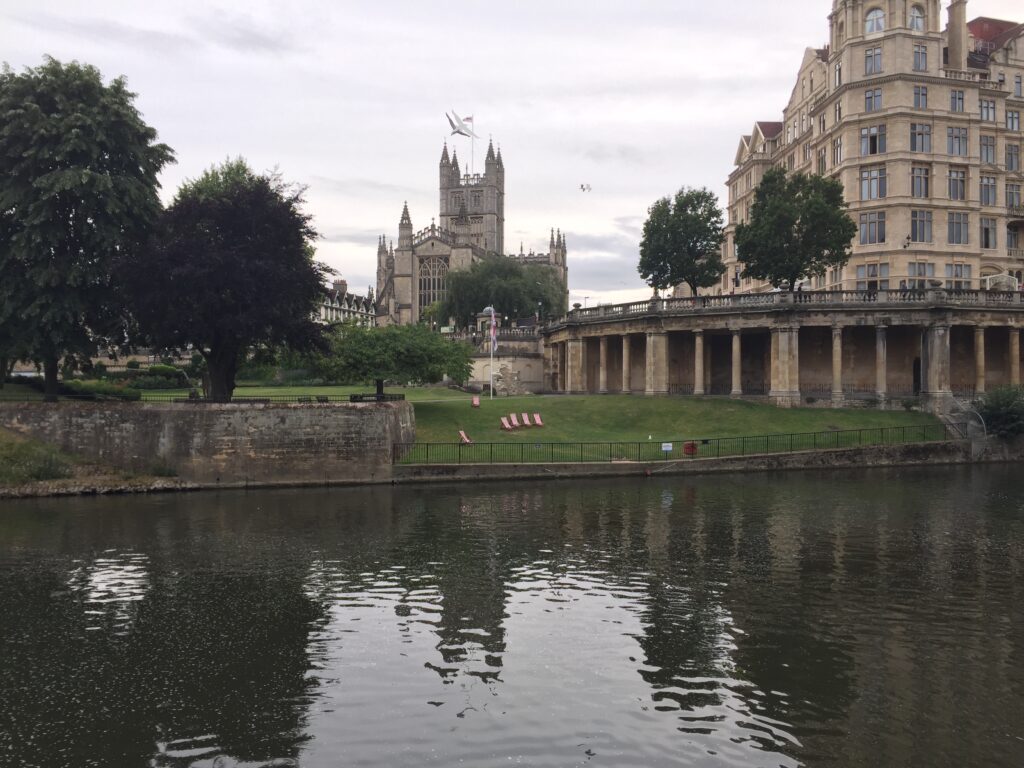
A UNESCO World Heritage Site
Bath is so impressive that it is included among UNESCO World Heritage Sites. It’s the only city in the UK to have a UNESCO World Heritage Site designation, earning this distinction in 1987. This World Heritage city of Bath represents two thousand years of history.
Known worldwide for the Roman influence that remains visible here, Bath is famous for its natural hot springs and captivating architecture featuring neoclassical Palladian buildings. Visitors descend upon Bath annually to enjoy its dozens of museums, fine dining, and a vibrant arts scene.
Bath earned a second UNESCO listing in 2021 when Bath was designated as part of the Great Spa Towns in Europe.
If you enjoy visiting UNESCO sites, know there are at least two more near Bath. Consider a day trip while staying in Bath to visit Stonehenge or Averbury.
About an hour from Bath, Stonehenge is home to the mysteriously erected monuments dating from nearly 3000 B.C. Speculation holds the site held special events and rituals, including sacred burials, healing, sun worship, or perhaps something unknown.
The Avebury Stone Circle, the largest in Europe, is found 27 miles from Bath and is another UNESCO site. Here, you can still witness a ring of stones nearly a quarter mile long. It’s still here after being erected almost 4,500 years ago.
Get Free Weekly Travel News Updates

The Best Places to Visit and Things To Do in Bath
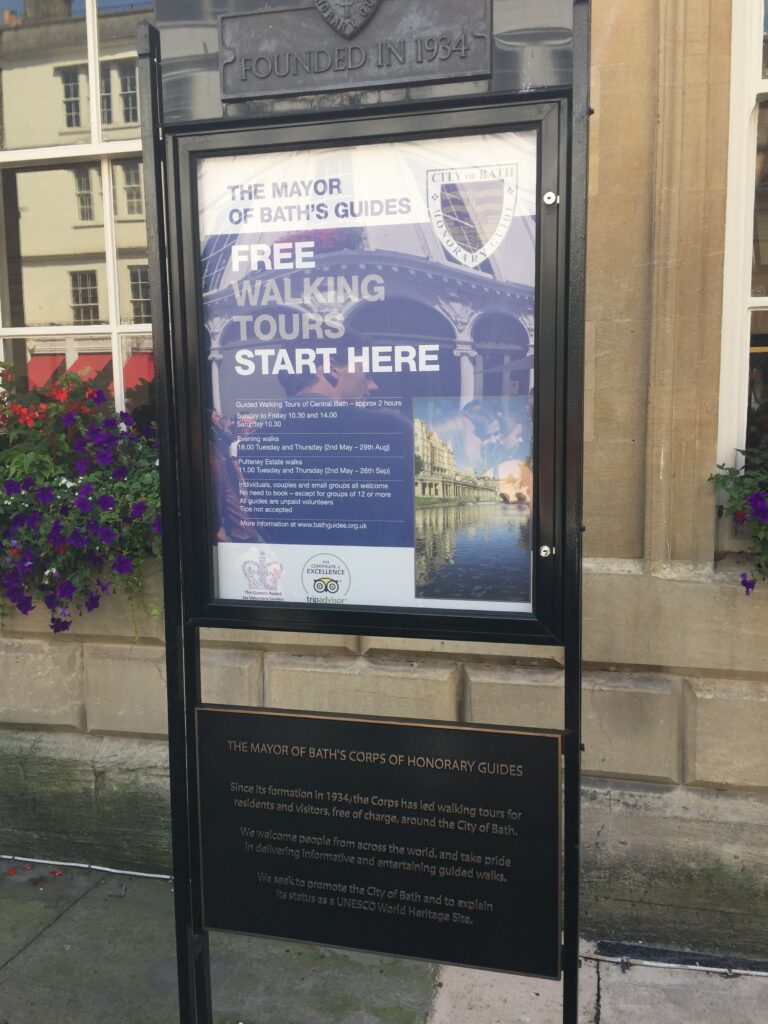
1. Get Familiar With Bath by Taking A Walking Tour
When you arrive in Bath, you likely will have a few attractions pre-selected to visit. If you have flexibility in your itinerary, a great way to learn how to fill in extra time with activities is to get acclimated to the city through a walking tour of Bath.
The city centre is very easy to navigate on foot. You’ll find a variety of free and paid tours available. We learned more about the city with our tour. These are a great way to see something of interest that you’ll want to return to later for a deeper exploration.
Our guide was excellent, and we were thrilled to get several behind-the-scenes views of the secrets hidden within Bath.
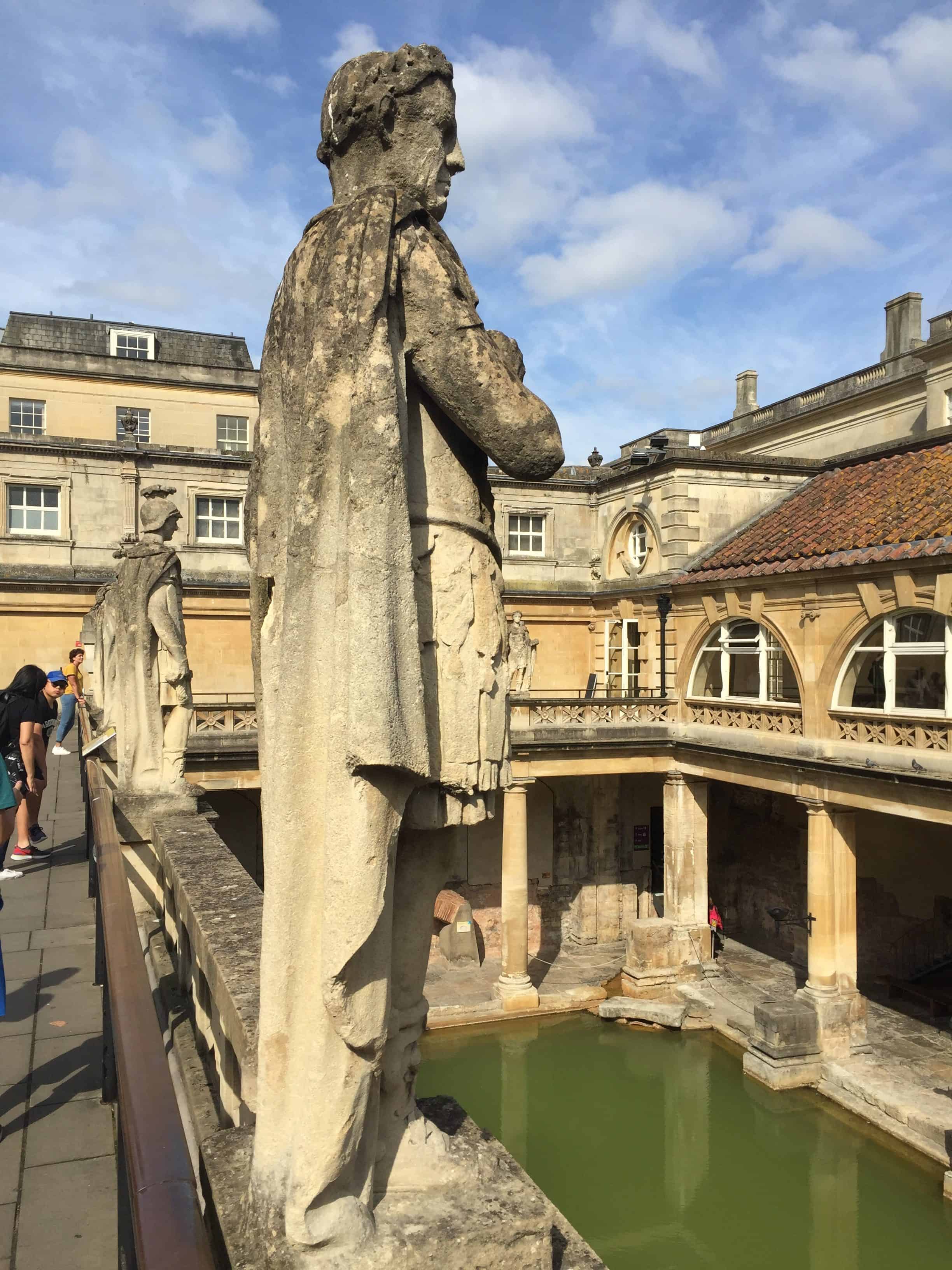
2. Visit the Historic Roman Baths
We begin our deep dive into the city of Bath at its most famous attraction, The Roman Baths. These are the best preserved of such baths in all of Europe.
During our visit, we could visit the Roman Baths without arranging entry tickets in advance. With fingers crossed, we planned to be there as close to opening time as possible and hoped for the best.
After breakfast at the Forester & Flower B&B, we arrived at the Roman Baths at 9:30 a.m. At this time, on a summer day, we only had three people in front of us in line, and we quickly got into the museum. Your experience may differ. Keep reading to see what we experienced with the entrance line as the day continued.
The entry includes an audio guide to supplement your visit to this historic site. We do recommend to take advantage of the entire audio tour. And take your time to read the presented information. You can walk past the exhibits and glance at the artifacts, but you’ll miss so much without investing in this learning opportunity to step back into Roman Britain.
Hot Springs of The Roman Baths
This attraction and the Temple arose around the local hot springs. With temperatures around 46°C, this area became the center of Roman life between the 1st and 5th centuries A.D. The city known back then as Aquae Sulis has a new name today (Bath), and those ancient hot springs still fill the pools in this location.
The hot spring water rises at a rate of 1,170,000 liters every day. Bubbling up into the King’s Bath, engineers built a reservoir below to supply water to the public baths.
We began our tour by viewing the main bath pool. Surrounded by statues of Roman rulers, the original roof no longer survives—the sunlit view of the large pool hints at a social gathering place from distant centuries. Visiting the Roman Baths is like entering a time machine as you’re transported to the Roman era in these surroundings.
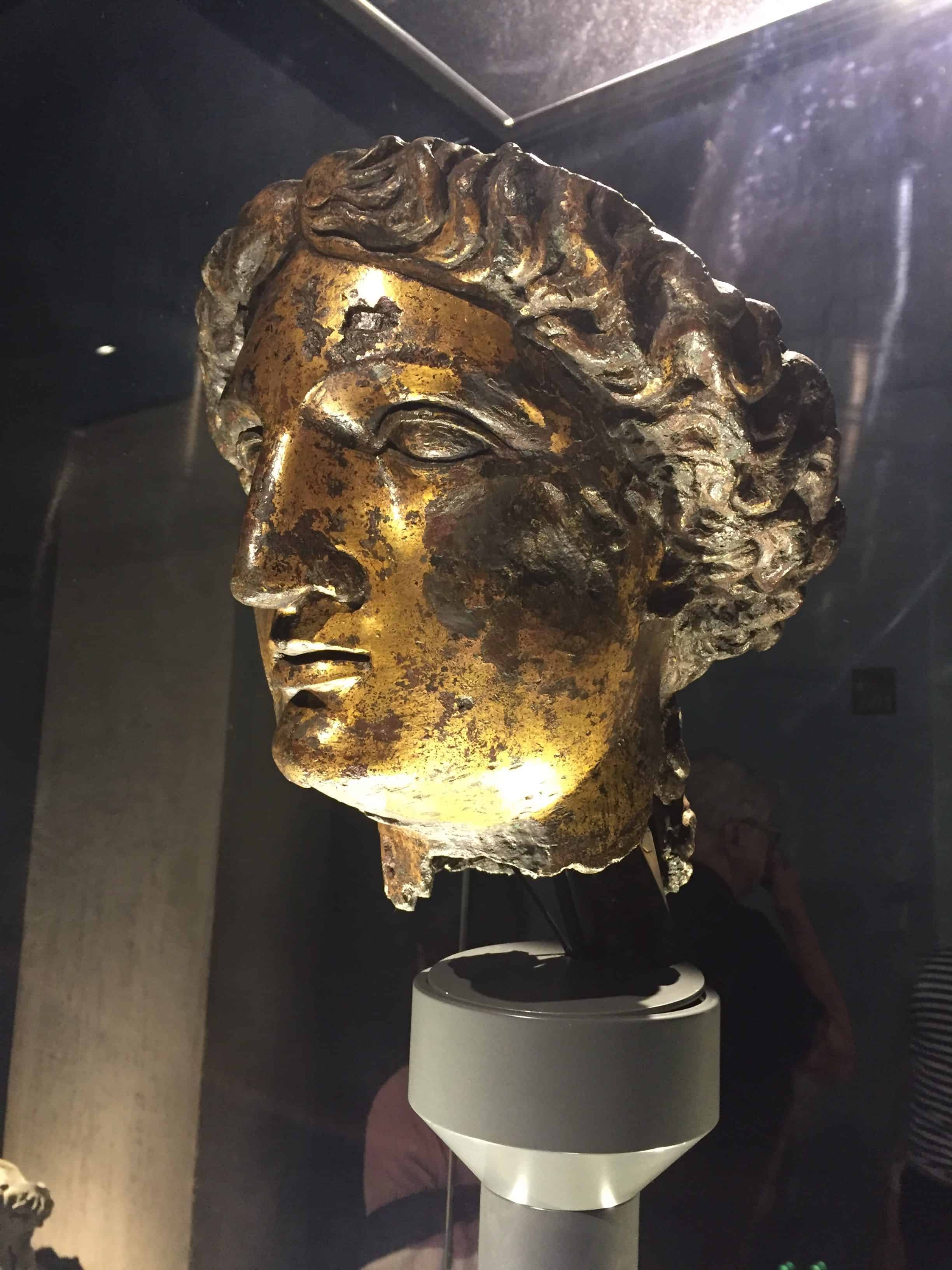
Main Sections in the Roman Baths Museum
The museum has four main sections: The Great Bath House, The Museum, The Sacred Spring, and the Roman Temple.
The museum is a wonderland of the ancient Roman presence here. You’ll see sculptures, jewelry, dioramas, and old Roman coins. The artifacts from Roman times continue with tombstones, statues, and religious items.
The most impressive artifact to us was the bronze head of the goddess Sulis Minerva. This ancient site was once used for religious purposes and healing, where it was believed the goddess Sulis Minerva provided divine aid to those seeking relief from ailments. Some ancient visitors who sought remedies for their ailments would stay overnight in special temple buildings. Upon waking, priests of the Roman god Aesculapius would help these people interpret their dreams.
“If they can’t be cured by drinking and bathing here, they will never be cured anywhere.” – A Practical Dissertation On The Bath Waters, Dr. William Oliver 1707
The spiritual heart of the site is its hot spring. Bathing here was also both a cleansing experience as well as a social experience. Ancient bathers here enjoyed food and drink, including oysters, snails, and other culinary delights of the day.
“We…erect altars at places where great streams burst suddenly from hidden sources; we honor sprints of hot water as divine.”
Senece Epistulae Morales 41.3, 1st century AD
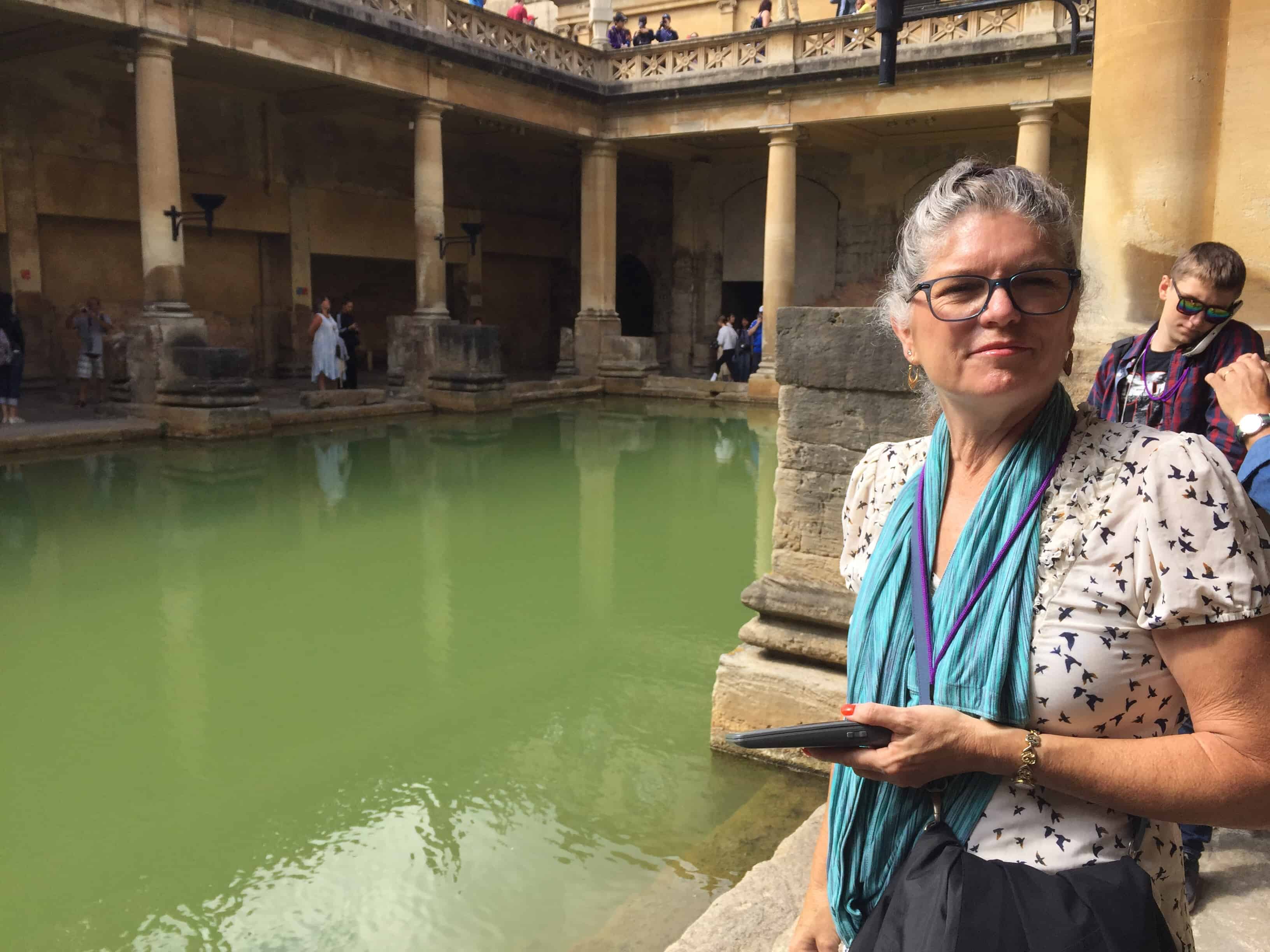
Bathing was separated by the sexes as prescribed by Emperor Hadrian. Slaves attended to visitors who came for baths, massages, and pampering.
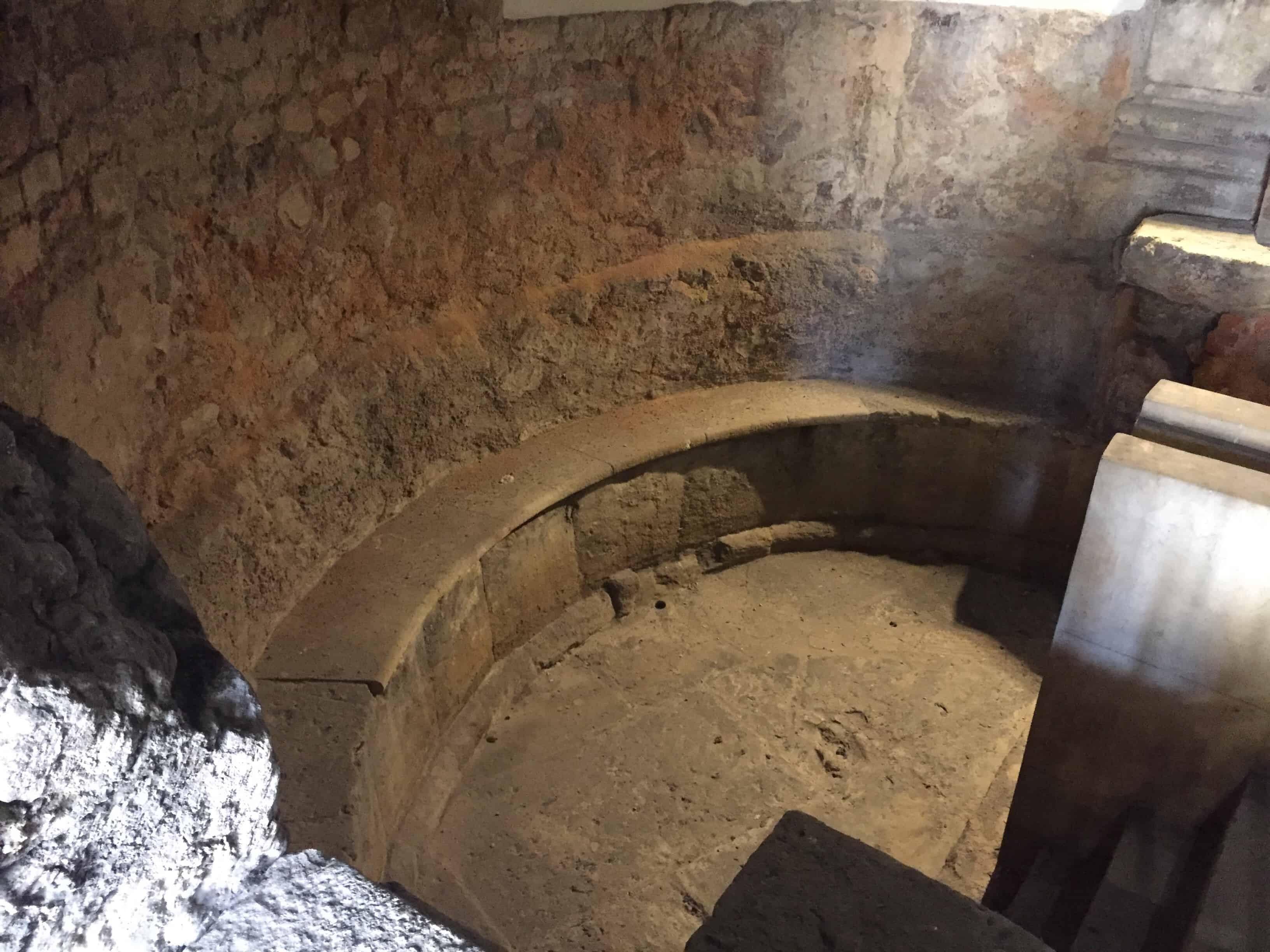
The water of the baths gained a reputation for healing and medicinal properties. After the Baths were rediscovered centuries after the Romans developed them, people came from miles away to seek cures and healing. Some sought to remedy ailments, including rheumatism and skin disease. Others came to enhance the chances of conceiving a child.
Curse Scrolls
One interesting item on display is the “Curse scrolls.” Romans would inscribe personal curses and private prayers on lead or pewter tablets. These were then tossed into the spring, summoning the aid of Sulis Minerva for justice in their appeals. An example of a surviving curse:
Solinus to the goddess Sulis Minerva. I give to your divinity and majesty [my] bathing tunic and cloak. Do not allow sleep or health to him who has done me wrong, whether man or woman or whether slave or free, unless he reveals himself and brings those goods to your temple.
The curse tablets are the only documents from Roman Britain inscribed on the UNESCO Memory of the World Register of significant documentary heritage.
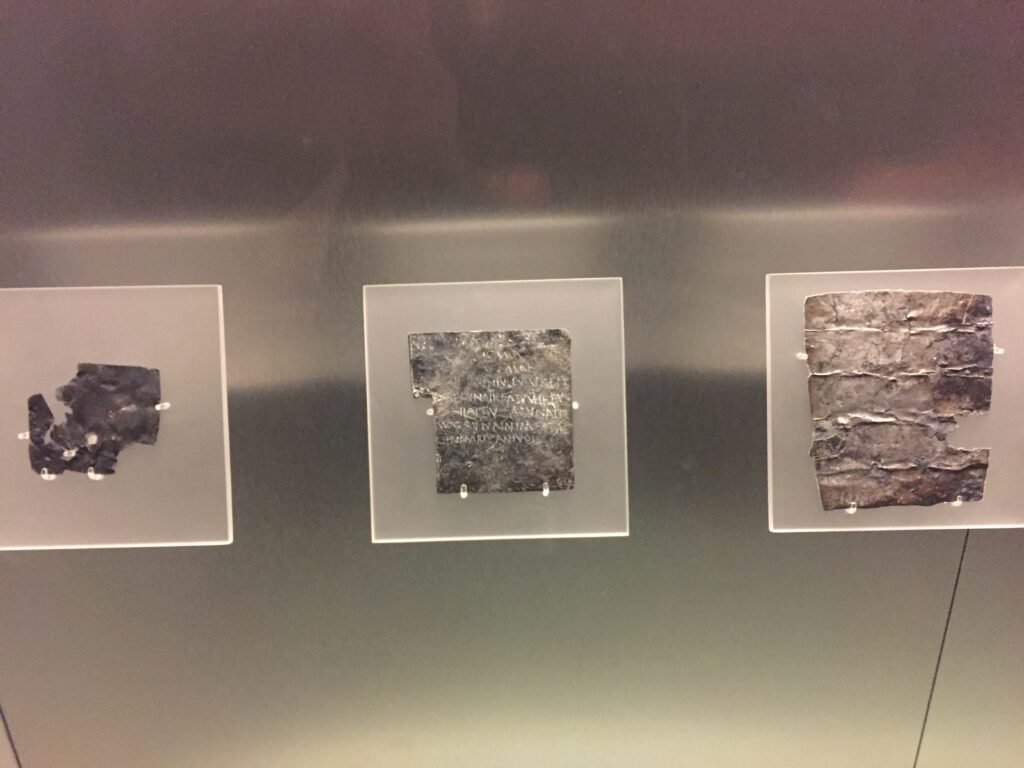
Audio Tour
The audio tour provided ample explanation of the various exhibits. We listen to each of the main narratives. Additional audio recordings offer perspectives from characters who would have been part of the experience – workers, slaves, etc.
A unique audio tour experience is available for young children. On their headsets, they can select to hear stories from characters ranging from a stone mason, a bathhouse worker to a servant. Seven different personas help young visitors understand life in and around the Roman baths during the Roman era.
The tour continues through the area known as the Great Bath. You can just imagine the ancient residents relaxing and socializing in these elegant and large pool areas. Pillars, statues of notable Romans, and mosaics surround the area.
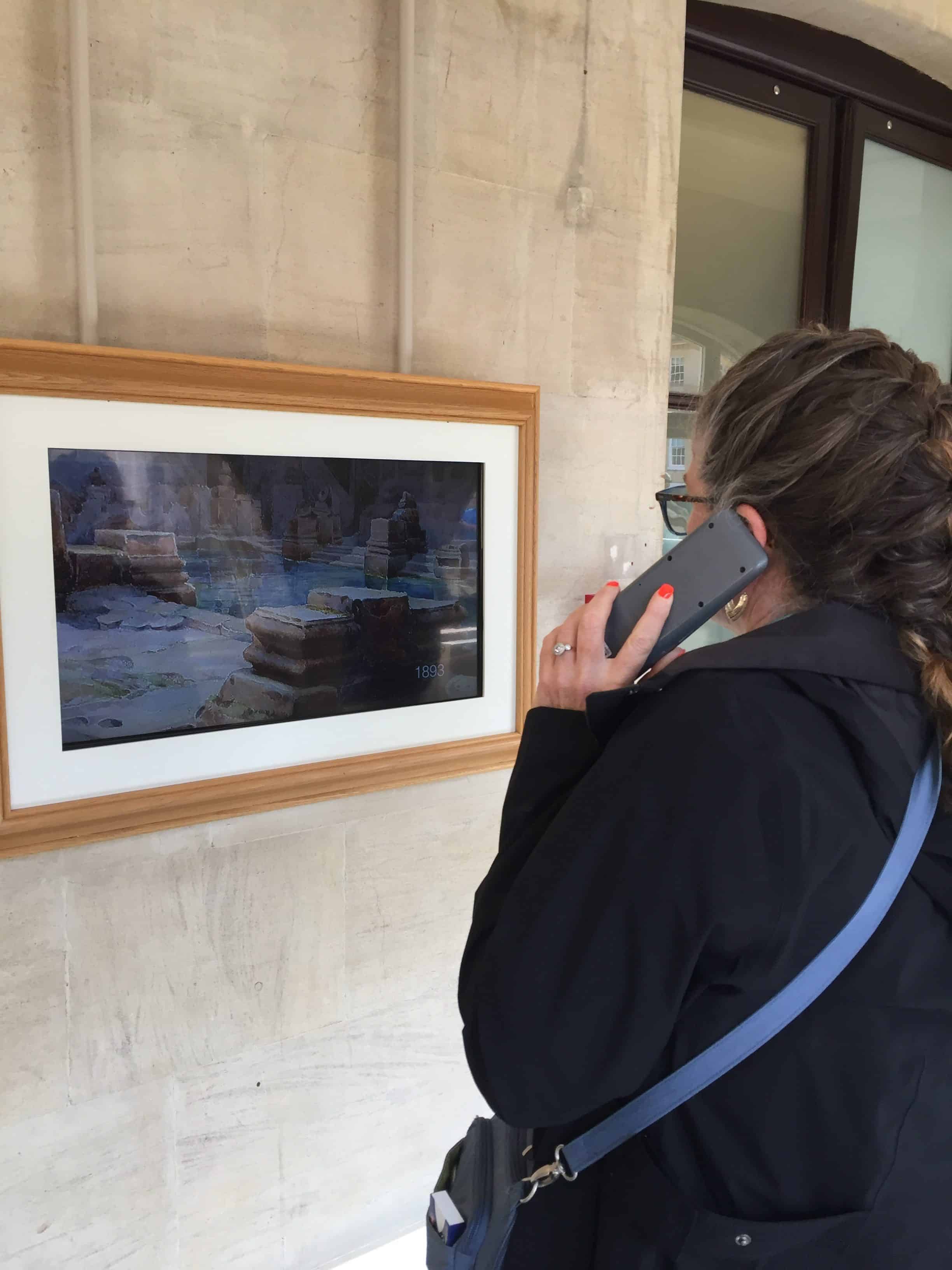
At the end of the tour, we took the opportunity to taste the spa water. Containing 42 minerals, it smells very bad but doesn’t taste as bad as the stink. The highest mineral concentration comes from sulfate, calcium, chloride, and sodium. For a more pleasant palate encounter, stop by the adjacent 18th-century Pump Room for tea, coffee, and snacks. This historic Georgian gathering place sits over the ancient Temple.
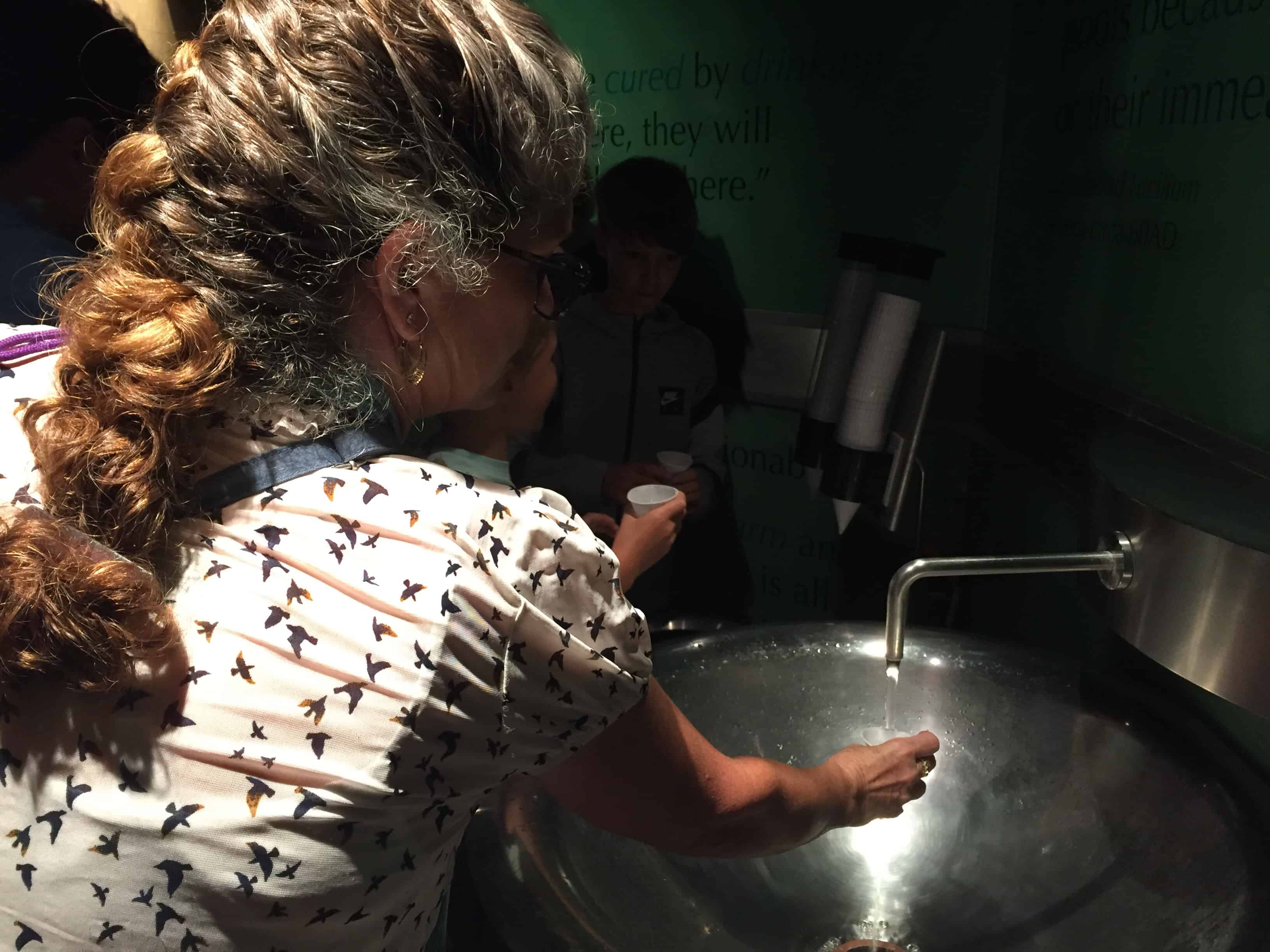
Our visit to the site lasted two hours. A visit here puts you in the footsteps of the ancient Romans as you see the ruins of their great bathhouse and temple, witness the magnificent steaming pool, and move about the original stone pavements. This is indeed a cultural treasure that has been wonderfully preserved.
When we emerged from the museum, the entrance queue was quite long – now wrapping around the side of the museum. Once again, the early birds were rewarded. To be on the safe side, book your tickets in advance. Click here for the Roman Baths Website.
Books Sold at The Roman Baths Bookstore
If you like to get familiar with places before your visit, here are a few select titles that were sold in The Roman Baths bookstore at the time of our visit:
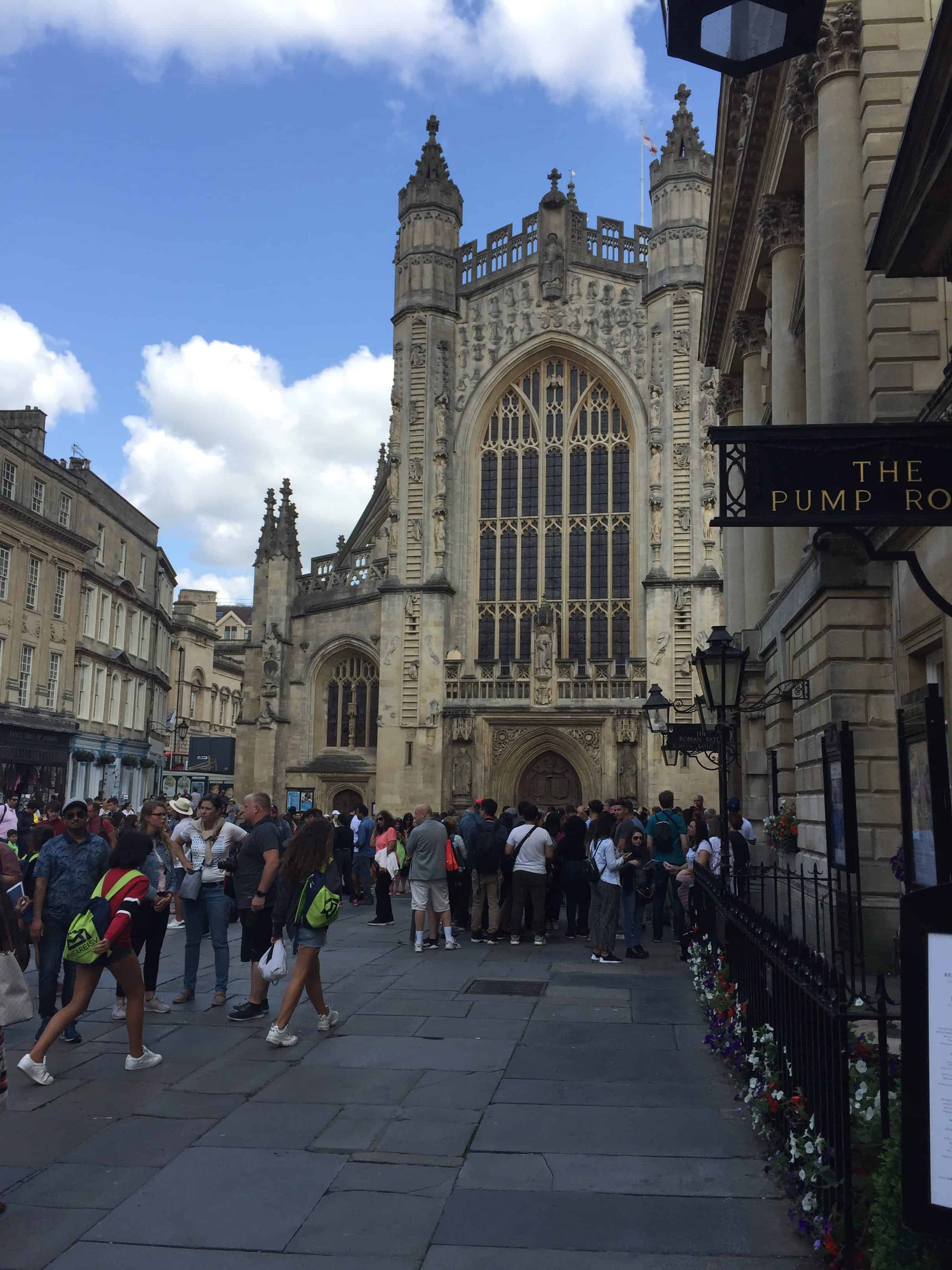
3. Take a Trip of Bath Abbey
Just across from the Roman Baths is the formidable Bath Abbey. An impressive medieval church, the present-day Victorian-Gothic style church standing on this site, was constructed between 1499 and 1626.
Originally founded as a Benedictine monastery in the 8th century, centuries later, it passed hands from the Roman Catholic church after the Reformation.
The church is most impressive from the outside. You’ll also want to tour the inside of the church. Inside, you’ll see beautiful stained-glass windows and an impressive vaulted fan ceiling.
There are memorials and plenty throughout the abbey floor and walls. Most of these memorialize notable people from the 18th and 19th centuries. Interestingly, even though Bath Abbey was a Roman Catholic church for centuries, this part of the church’s history is given only a minor nod.
If you can walk up 212 steps, you may be interested in walking to the top of the tower. A walk up a tight spiral staircase will get you to your vantage point for an impressive view over the city center. There is a small fee for this section.
Tips For Visiting Bath Abbey
You can tour Bath Abbey alone or opt for a hosted tour. During our visit, half of the church was inaccessible to view. Your experience may differ.
Should you want to participate in a service or attend a musical event hosted at the Abbey, consult the “What’s On” section of the Bath Abbey website to learn of events available during your visit.
Entrance is free, though a donation is requested. Bath Abbey is an active working church in the community, so it is sometimes closed for general visiting due to services or special events. For example, we visited on a Sunday, so our window for entering the church was limited due to the schedule of Sunday services.
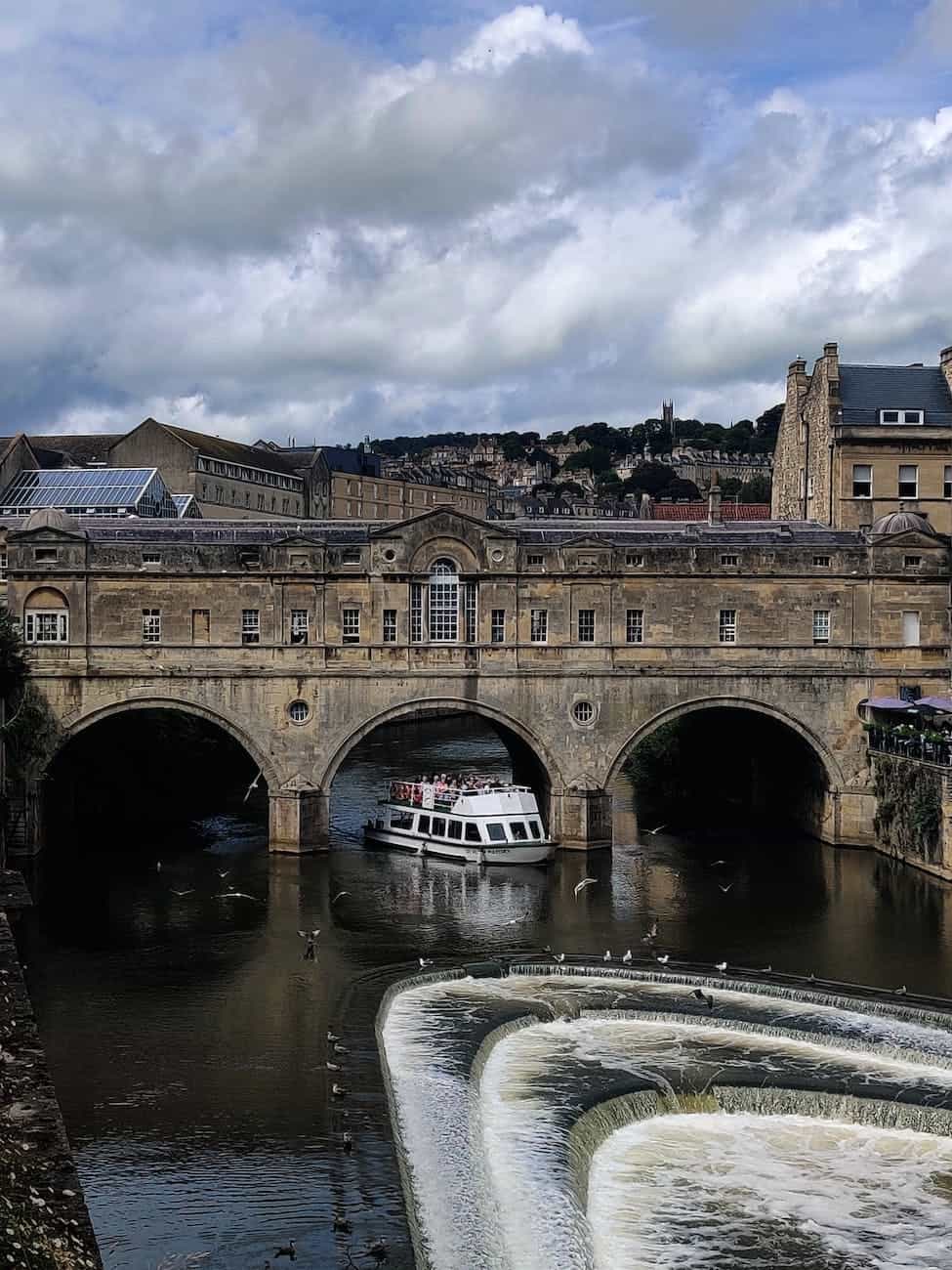
4. Walk Along Pulteney Bridge
Bath is an excellent city in which to take a stroll. One place you’ll want to wander over is Pulteney Bridge. It is only one of two bridges in Europe that supports shops. The other such bridge is the Ponte Vecchio in Florence; we’ve had the pleasure of visiting both.
Robert Adam designed the Grade I listed bridge. Completed in 1774, the bridge connected land owned by the Pulteny family to the city of Bath. Pulteney Bridge crosses over the River Avon with three arches. The bridge is home to specialty stores and restaurants.
Even if you only have one day in Bath, this is an easy item to include in your itinerary. And if your visit to the bridge accommodates the time, two nearby museums are nearby – the Holburne Museum of Art and
Victoria Art Gallery.
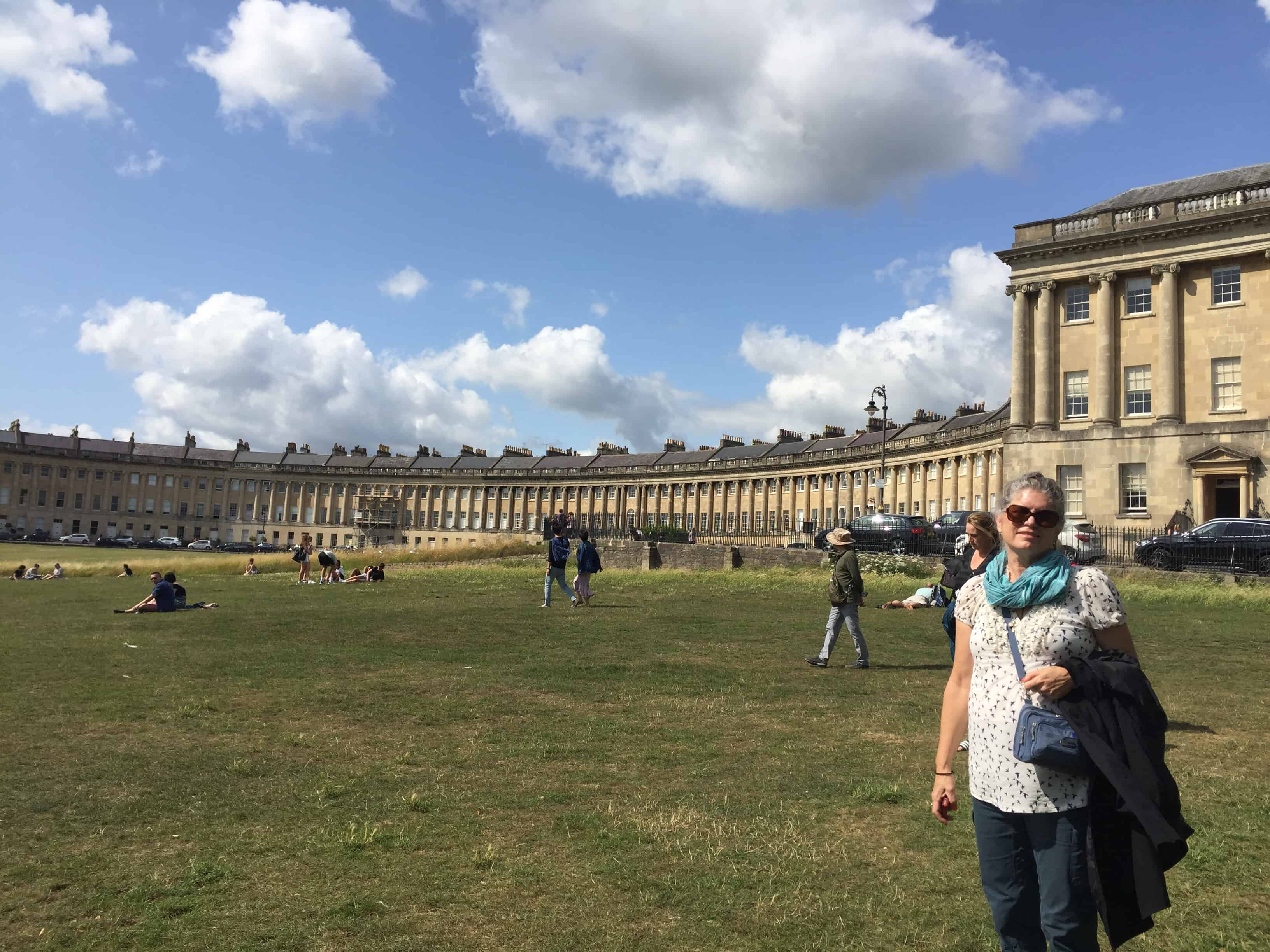
5. Explore Bath’s Georgian Roots in the Royal Crescent
Shifting our attention to architecture, Bath boasts nearly 5,000 listed buildings. Premier among these is the Georgian-styled Royal Crescent. Built in the late 1700s, the 600-foot crescent-shaped row of 30 terraced homes was built by John Wood the Younger. Today, the iconic Royal Crescent is a World Heritage Building.
Viewed from the outside, the dominant structure affirms its status as one of the truly great classical structures. It’s one of the spots in Bath that you’ll want to capture in photographs.
The experience of Royal Crescent life is available to tourists as No. 1 Royal Crescent is a public museum maintained by the Bath Preservation Trust. Step inside to see how the wealthy residents of Bath would have lived in the 18th century. Your docents will reveal the backstories of the former residents. The museum is adorned with the fineries that the former residents would have in their homes – fine art, elegant dining areas, and fashion items worthy of the social class.
During our tour of the area, we learned that the housing area adapted to changing styles. In the age of the Romantic poets who idealized pastoral life, every home entrance was designed to provide a rural view when exiting one’s home.
You can even book a room at The Royal Crescent Hotel & Spa and experience the elegant facilities. Visitors can also stop in to enjoy afternoon tea in classic style.
A visit to Bath would be incomplete without experiencing the legacy of its renowned Georgian architecture.
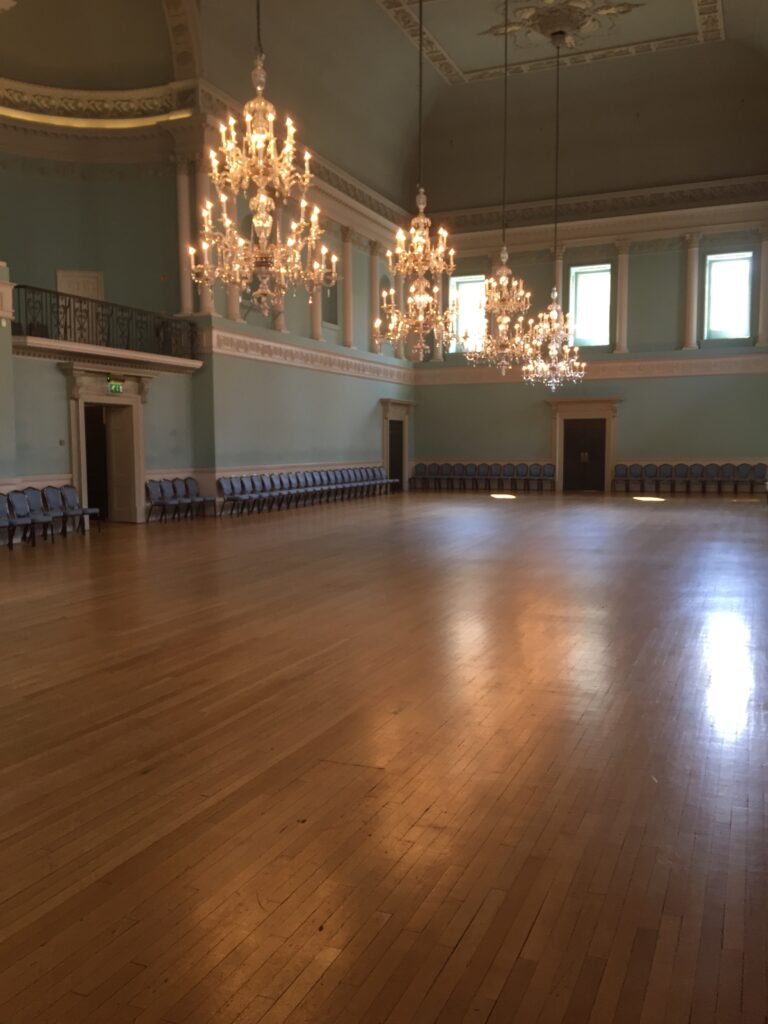
6. Get Dressed Up at the Fashion Museum Bath
The social scene comes to life at the Fashion Museum Bath. This world-class collection of historic dress showcases Georgian designs to current-day leading fashions.
The cornerstone exhibit, A History of Fashion in 100 Objects, highlights fashion from the 1600s to our 21st century in, you guessed it, 100 objects. See how the wealthy Bath residents of the Georgian era adorned themselves in apparel. The collection provides a unique historical journey through the lens of fashion.
In addition to the museum’s permanent exhibits, additional temporary exhibits keep things interesting. Check the museum’s website to see what’s on during your visit.
Since its opening in 1963 as the Museum of Costume when Doris Langley Moore donated her private collection, this museum has attracted tourists who appreciate the fashion world. Today, an audio guide is available to explain the various exhibits of outfits spanning 400 years.
This museum also provides an interactive experience. Guests can try on outfits to place themselves into the prior eras of dress. It’s also a great way to understand how clothing would have felt to be worn at different points in history.
Beyond viewing the attractive displays, visitors can purchase curated fashion items, accessories, and jewelry.
Experience 18th Century Social Life at The Assembly Rooms
The Assembly Rooms are popular in Bath for private events and available for public viewing when not in use. First opened in 1771, the Georgian architectural building designed by John the Younger provided a venue for 18th-century entertainment called an ‘assembly.’ Here is where socialites would gather for dance, teatime, enjoyment of music, or to be in each other’s company.
The main rooms here include:
The Ball Room – used to host dances with attendance ranging up to 1200 guests per session.
The Tea Room is a space for refreshments and musical concerts, including an intermission to enjoy tea.
The Octagon and Card Room – a space joining The Ball Room and Tea Room where attendees could listen to music, play cards, or listen to the organ on Sundays.
Film fans may be interested to learn that a few popular features were filmed at the Assembly Rooms, including Northanger Abbey (1987), Persuasion (1994), Bertie & Elizabeth (2001), Persuasion (2006), The Duchess (2007), Bonekickers (2008).
Since the Assembly Rooms are used for booked events, please check in advance of your time in Bath to see if you will be able to visit.
7. Bath’s Historic Circus
Bath has a historic circus, but not of the type featuring clowns and elephants. Reaching back to the Roman-Latin roots, the ancient “circus” refers to a semi-circle loop of historic townhouses. When you visit the Royal Crescent, know that the Circus is just a block away.
It’s another excellent example of Georgian architecture from the mid-1700s. English architect John Wood the Elder designed this masterpiece, which was initially known as the King’s Circus. He was influenced by Druid culture and referenced the layout of Stonehenge in his design. Completing the Circus took longer than Wood the Elder had years left of his life, so construction was completed by John Wood the Younger.
The collection of homes was inhabited by an impressive “who’s who” list of Somerset socialites. It seems fitting that they resided in English Palladian architecture, which honored classical stylings.
Today, you can visit the circle of townhomes that border a lawn and a large roundabout. The Circus is another must-stop for tourists wanting to explore the architectural masterpieces in Bath.
8. The Jane Austen Center
Bath is synonymous with the great author Jane Austen in the literary world. A one-time resident of the city, this is where she wrote some of her most prized material. She found inspiration from the city’s socialites and their scandals. The characters she observed in Bath became central figures in her books, providing a glimpse of life in this city. Notable works include Persuasion and Northanger Abbey. If you plan to visit Bath, one of our tips is to immerse yourself in a Jane Austen novel before arrival.
This is the perfect place to immerse yourself in things Jane Austen, and there is no better place than the Jane Austen Heritage Centre.
The nearly 300-year-old Georgian townhouse pays tribute to the author and is a top attraction in Bath. The Jane Austen Centre provides a lens on the author’s life and works and the Regency period of her day. She resided in Bath between 1800 and 1806.
This will be right up your alley if you enjoy interactive and immersive exhibits. Your hosts are dressed in Regency period fashion, and the displays will connect you to the life of Jane Austen. A film is available that describes the author’s life.
You can also find walking tours available in Bath, some hosted by the Centre, that walk you through parts of the city highlighted in her works. We took a fantastic walking tour in Bath that ended at the Gravel Walk, where Jane Austen came to live.
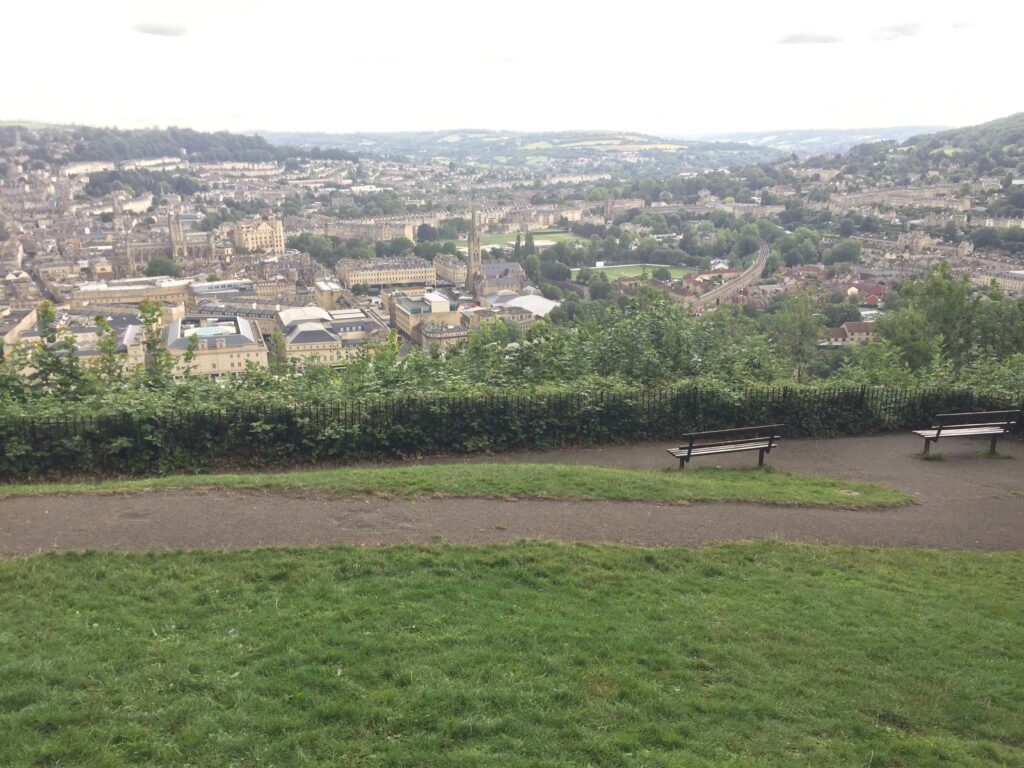
9. Enjoy the View of Bath from Alexandra Park
Getting yourself to Alexandra Park is a great place to end an afternoon in Bath. We finished one of our sightseeing days in Bath with a stop here. It was a great place to marvel at the wondrous views from atop the park overlooking the city.
You’ll find the park south of Bath city center, perched upon a hillside above the river. Located on top of Beechen Cliff, the journey to the park is worthwhile to see Bath from on high. The park is peaceful, with plenty of shade from the mature trees. This is perhaps one of the best locations in Bath to enjoy the setting sun.
10. American Museum & Gardens
This is the only Americana history and culture museum outside the United States. Exhibits change throughout the year and often cover fashion, photography, and art.
11. Herschel Museum of Astronomy
You can visit the house where William Herschel discovered the planet Uranus in 1781 using a personally designed telescope.
12. Holburne Museum
Located in a Grade I listed building, the Holburne houses an impressive fine and decorative art collection. 18th-century culture is displayed with paintings, sculptures, fine china, and banquet-worthy specimens. The museum’s namesake Sir William Holburne collections are also on display.
13. Mary Shelley’s House of Frankenstein
Did you know that Mary Shelley conceived of the Frankenstein story in Bath, England? Today, you can visit Mary Shelley’s House of Frankenstein within a few blocks of her former residence. It’s a top attraction that bridges a museum with storytelling over four themed floors. See the impact of Frankenstein in pop culture and end with an immersive experience that will have you scrambling for the exit.
In Bath, you can also visit the site where Mary Shelley wrote her famous novel in 1816-1817. Mary Wollstonecraft Godwin took lodgings in 1816 at a house that was later demolished to make way for an extension of the Pump Room. While attending scientific lectures by Dr. Wilkinson, she heard his proposition that someday, electricity might bring the inanimate matter to life. And thus, her inspiration to write Frankenstein took root.
14. Prior Park Landscape Garden
This famous park offers a great example of the Serpentine landscape style. Wooded walkways and lakes provide a serene environment. The grounds also boast a Palladian mansion and bridge.
15. Sally Lunns Historic Eating House & Museum
Located in one of the oldest houses in Bath, the kitchen museum shows where the baker Sally Lunn created the first Bath Bunn. This regional specialty, which originated in Bath, is known worldwide. Experience an original Sally Lunn bun baked from the secret recipe.
16. Theatre Royal Bath
This Georgian theatre from 1805 offers entertainment year-round, including drama, opera, comedy, dance, and concerts. Check the theatre’s website to see what’s on during your visit.
17. Thermae Bath Spa
You can experience an authentic Bath spa, just as people have done for centuries in this city. This spa uses the same mineral-rich spring water that feeds the Roman Baths. Remember, you’re on vacation – so indulge and relax in the spa for an experience you’ll remember forever.
18. Victoria Art Gallery
Art lovers will enjoy the expansive collection of paintings and sculptures, including many representing Britain’s finest artists. The permanent collection is free to visit.
Book A Bath Tour – 3 Hour Private Tour with Local Guide
Rated 5 Stars on Viator with Over 140 Reviews
Best Places to Eat in Bath
There are many food choices in Bath. Here are some of the top tourist favorites and our personal choices.
Menu Gordon Jones – Enjoy a Michelin dining experience that blends textures and contrasts of English, Indian, and Asian influences. This restaurant is more costly than average and provides a superb atmosphere for a wonderful dining experience.
Crescent Restaurant & Bar – As you might guess from its name, this restaurant is near the Royal Crescent landmark. You’ll find a fresh all-day menu from the husband & wife duo of Simon & Leanne.
Ponte Vecchio – Given the early Roman influences that dominated the city, a fine Italian meal can seem most fitting. You’ll find exceptional Italian Cuisine at Ponte Vecchio, set in one the most scenic locations near the Pulteney Bridge and River Avon.
Franco Manca Sourdough Pizza – Located adjacent to the Bath Spa Train Station, you’ll find freshly made sourdough pizzas here. Vegan & gluten-free options are available. We found Franco Manca to be popular during our visit to Bath. The pizzas here are really, really good. We’ve had several and love their sourdough crust.

Our Top 3 Picks: Where To Stay in Bath, England
#1 TOP PICK
⭐️⭐️⭐️⭐️⭐️
Gainsborough Bath Spa
✔️ Luxury hotel
✔️ Grade II listing buildings
✔️ Access to thermal waters
#2 PICK
Hotel Indigo Bath
✔️ Boutique eco-certified hotel
✔️ Hypo-allergenic bedding
✔️ On-site restaurant
#3 PICK
Oldfields House B&B
✔️ Upscale bed & breakfast
✔️ Close to Roman Baths
✔️ Private car park
The Forester and Flower
This boutique hotel offers five uniquely decorated rooms. The location is a 10-minute bus ride from the city center. That makes it close enough for easy access to the city with a stay in more peaceful surroundings. We stayed at this location during our visit to Bath.
🐶 Pet-friendly accommodation in Bath – Grosvenor Villa
Find more places to stay in Bath, England
A Snapshot of Bath’s History
Bath History 1st to 5th Century A.D.
The timeline of Bath’s history is lengthy. Here are a few of the highlights of the city’s rich history.
The first Roman temple structures were erected near the hot springs. Nearby, the construction of city walls provided for defense. Christians arrived, and by the end of Roman rule in Britain during the 5th century, Bath became an abandoned area.
Bath History 6th to 10th Century A.D.
The time of famous battles emerges as the Saxons go at it. Convents come, and conflicts arise over monasteries. By 900, Bath is a trading area with an active market. On Whitsunday In 973, Edgar, King of England, is crowned and anointed with his wife at Bath Abbey.
Bath History 11th to 15th Century A.D.
This epoch gets interesting with more details preserved for us. Here’s a selected rundown through the years of this period:
1090: The Bishop of Wells moves the episcopal seat to Bath, giving it city status
1148-1161: The consecration of The Bath Abbey
1333 – The monks of Bath Abbey establish a weaving trade
1499 – With Bath Abbey in poor condition, a reconstruction effort gets underway by Oliver King, Bishop of Bath and Wales, being completed in 1533
1539 – Bath Abbey is surrendered during the dissolution of the monasteries. Also this year, Dr. John Jones publicly endorses the city’s waters for the first time as having medicinal properties.
1572 – Bath Abbey deteriorates again and is roofless. The corporation of Bath takes it on for restoration as a parish church. Six years later, a drinking fountain was installed in the Baths.
1597 – The city’s poor obtain free use of the local mineral water
1613 and 1615 – Anne of Denmark visits Bath to remedy her health
1657 – Coach service begins to Bath from London
1676 – Dr. Thomas Guidott publishes “A discourse of Bathe, and the hot waters there.” Also, Some Enquiries into the Nature of the Water”. This is the first published account of the city waters and its medicinal properties.
1687 – Mary of Modena, queen consort of James II of England, visits Bath with the hope the special waters will aid in conception. And by year’s end, she is pregnant with James Francis Edward Stuart.
Bath History – The 1700s
The 18th century in Bath’s History includes significant milestones in the city’s architecture. Here’s a short recap, along with a few more notable moments during the century:
1704: The first pump room is built in Bath.
1727: Workers excavating a sewer find the gilt bronze head of the statue Sulis Minerva from the ancient Roman Temple
1766 – 1774 – Construction period for the Royal Crescent house
1769 – Completion of the Circus houses
1769 – 1744 – Construction of the Pulteney Bridge
1780 – The first record of a Sally Lunn bun or teacake comes out of Bath. This is also the year of anti-Catholic unrest in Bath.
1781 – The first observation of the planet Uranus takes place from William Herschel’s back garden in Bath
Bath History – The 1800s – 1900s
1801 – Jane Austen becomes a Bath resident and will reside here through 1806
1840 – The Great Western Railway opens in Bath to Bristol Temple Meads and in 1841 through to London Paddington.
1863: St. John the Evangelist Roman Catholic Church is completed
1897 – The Roman Baths are opened to the public
1942 – The Bath Blitz: Three German aerial bombing raids kill 417 people. Several buildings are damaged in Bath, including the Assembly Rooms, St. Andrew’s church, and All Saints Chapel.
1963 – The Beatles play the Pavilion in Bath
1970 – No. 1 Royal Crescent is opened to the public as a historic house museum
1987 – The City of Bath is awarded UNESCO World Heritage Site status
When is the Perfect Time to Visit Bath?
All year long, you’ll find events scheduled in Bath. Encompassing the worlds of music, literature, film, and food, odds are you can find a special event during your visit to Bath. The following are some of the highlights you can expect most every year.
February – Bath Bachfest: Celebrate the music of Johann Sebastian Bach
March-April – Get a belly full of laughs in Bath’s Comedy Festival
May – Bath Festival celebrates music and books in a special festival spanning ten days
June – Pub in the Park rings in summertime with food and drink in Royal Victoria Park where you can enjoy the festivities and admire the botanical gardens.
July – Bath Carnival promises a wonderful time for all in this annual celebration
September – The Jane Austen Festival lets you enter the world of Bath’s renowned author. Join hundreds of costumed attendees in guided walks, lectures, concerts, and more.
September – Bathscape Walking Festival lets you immerse yourself in the city’s landscapes via group walks and self-guided paths. The event is perfect for nature lovers and those who want a deeper experience of Somerset’s heritage.
November Events: Mozartfest: Celebrate the music of Wolfgang Amadeus Mozart in Bath. FilmBath Festival brings the latest creations from the world of film to Bath.
November – December: Bath Christmas Market – Enjoy the glory of the Christmas Season in Bath. Stroll down artisan-lined streets, smell Christmas in the air, and savor the season’s flavors. It’s lots of fun for the whole family. Visit the website for dates and times.
Catholic Mass Service in Bath
Located just a short walk from the Roman Baths, the Church of St. John the Evangelist provides Catholic worship services. The church is beautiful. You can learn about its history, including the destruction encountered during WWII. During our visit, the church catered to the local Polish community with services in both English and Polish.
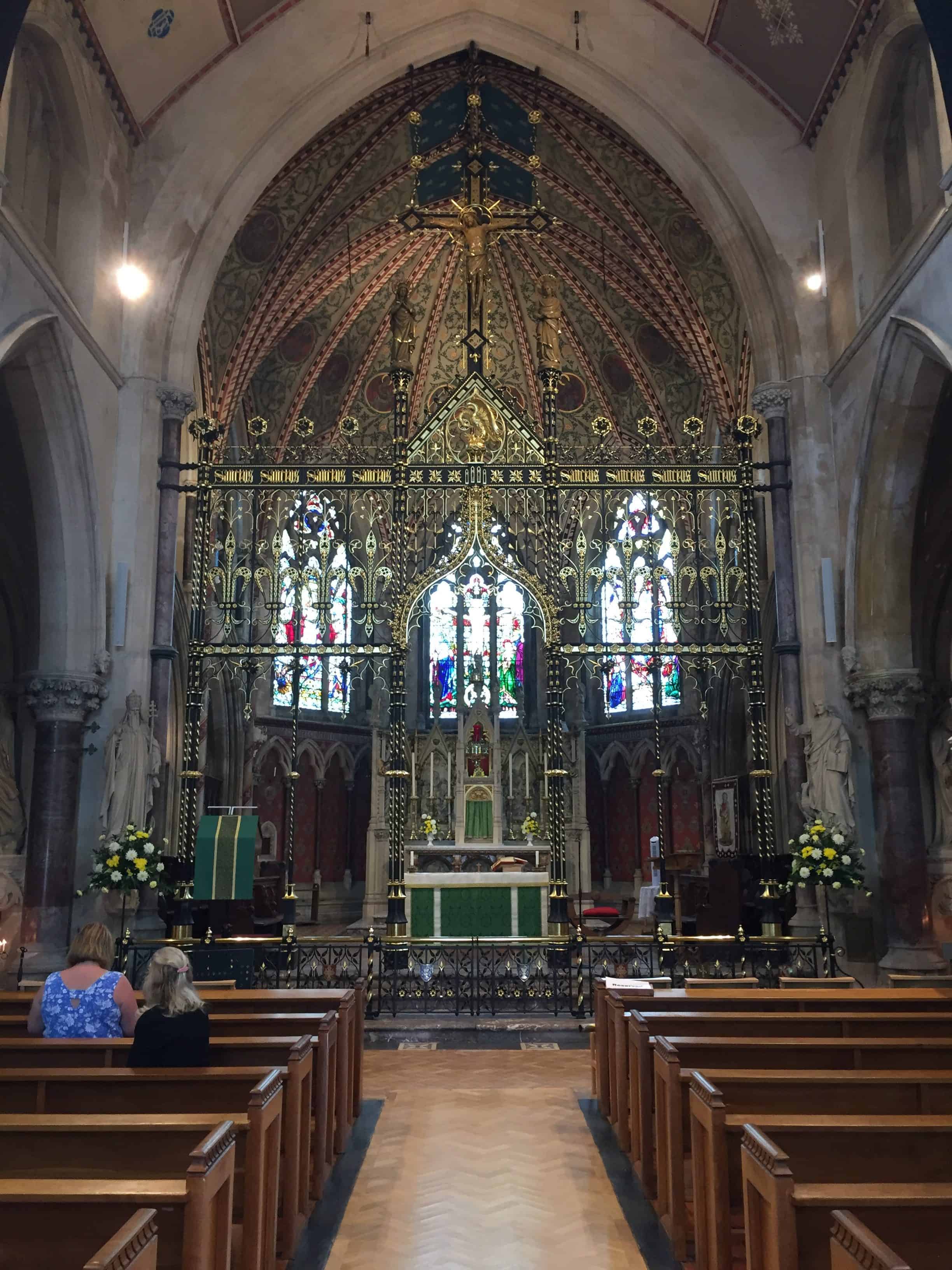
How Long to Stay in Bath
Bath grew on us during our stay. We feel 2 1/2 days was the perfect amount of time to sample the city and nearby area. This town is a little flavor of Italy in England. You’ll want at least one full day to see the essential sites in Bath. Two days would be even better for a deeper immersion.
Places to See Near Bath
Bath also makes an excellent hub city where you can stay and take excursions to nearby areas. For such extra-curricular travel, add another day or two.
Consider booking several days in Bath. Use a few days to explore the city itself.
You can add a day or two for an excursion to nearby areas. Here are a few options to consider:
Glastonbury Travel
Somerset – Visiting the Charming English County
A Perfect Weekend in Wells
Getting to Bath
To embark on a journey from London to the historic city of Bath, travelers have several convenient options. One of the most efficient methods is taking a direct train from London Paddington Station. The journey is approximately 90 minutes, offering a comfortable and scenic ride through the English countryside.
Alternatively, for those who prefer driving, the A4 and M4 motorways provide a direct route to Bath, with the trip typically taking around two to three hours depending on traffic. Once in Bath, visitors can utilize the various parking options available throughout the city.
For the latest information on parking availability and services, it’s recommended to visit the Bath Car Parks website here.
Frequently Asked Questions For Visiting Bath Somerset
How many days should I plan to visit Bath?
The ideal amount of time to fully experience Bath Somerset would be around 2-3 days. This allows enough time to visit the main attractions, such as the Roman Baths, Royal Crescent, and Pulteney Bridge, while leaving room for relaxation and exploring the city’s charming streets and quaint shops.
Is it worth staying overnight in Bath?
Yes, staying overnight in Bath is worth it. The city offers a rich history with its Roman Baths and Georgian architecture and cultural attractions like the Jane Austen Center and Thermae Bath Spa. An overnight stay lets you explore these sites leisurely and enjoy the charming local restaurants and shops without feeling rushed.
Is Bath an expensive city to visit?
Bath, England, is generally considered a moderately expensive city to visit, especially compared to other destinations in the United Kingdom. The city’s rich history, stunning architecture, and famous Roman Baths attract many tourists, which can drive up prices for accommodations, dining, and attractions. Hotels and lodgings in Bath can be pricey, particularly during peak tourist seasons. However, there are options for budget accommodations, such as hostels or bed and breakfasts. Dining out can also range from affordable pubs and cafes to high-end restaurants. Entrance fees to major attractions like the Roman Baths or the Thermae Bath Spa can add to the overall cost of a visit. Planning ahead and booking in advance can help manage costs and make your visit to Bath more affordable.
Is Bath a walkable city?
Bath is generally considered a very walkable city. The compact nature of Bath’s city center, combined with its rich historical and architectural heritage, makes it an ideal location for exploring on foot. Many of Bath’s most famous attractions, such as the Roman Baths, Bath Abbey, and the Royal Crescent, are within walking distance. The city’s pedestrian-friendly streets and numerous parks and green spaces offer pleasant routes for leisurely strolls.
Is Bath a good city for shopping?
Bath is indeed a fantastic city for shopping enthusiasts. The city offers a unique blend of independent boutiques, high-street brands, and vibrant markets, all set against the backdrop of stunning Georgian architecture. Milsom Street, often at the heart of Bath’s shopping scene, boasts a mix of designer and mainstream shops. For those who appreciate eclectic and one-of-a-kind finds, Walcot Street, known as Bath’s artisan quarter, presents an array of quirky and independent stores. Additionally, Bath is home to the historic Guildhall Market, where shoppers can explore stalls offering everything from local produce to handmade crafts.
Books to Plan Your Perfect Visit to Bath and Somerset
Plan a perfect trip to Bath, England, with the help of these books:
Recommendations For Your Bath Visit
- Visit the Roman Baths right at opening or after 4 p.m. to avoid the crowds
- Bypass Bath Abbey unless you attend a service or can have a guided tour
- Read a Jane Austen or Mary Shelley novel before your visit
Listen to our Bath England Podcast Episodes
Named to the Top 100 Travel Podcasts by Feedspot!
Closing Thoughts
In conclusion, Bath Somerset is a destination that truly embodies a blend of history, culture, and natural beauty, making it undeniably worth visiting. Whether you’re soaking in the ancient Roman Baths, marveling at the stunning Georgian architecture, or enjoying a serene stroll through the beautiful parks, there’s no shortage of activities to ensure you have a good time. As you explore everything this charming city has to offer, you’ll discover why Bath continues to captivate and enchant visitors from around the globe.
Thanks for reading. We hope to see you at the places where we go.
Julie & Art
#bath #somerset











10 Comments
Comments are closed.